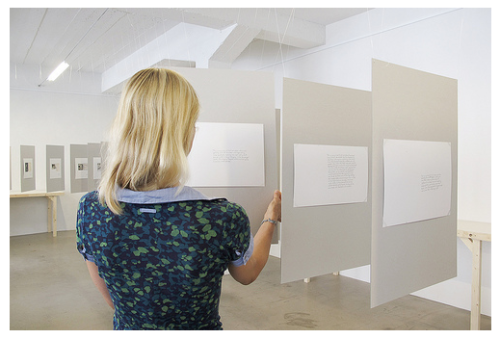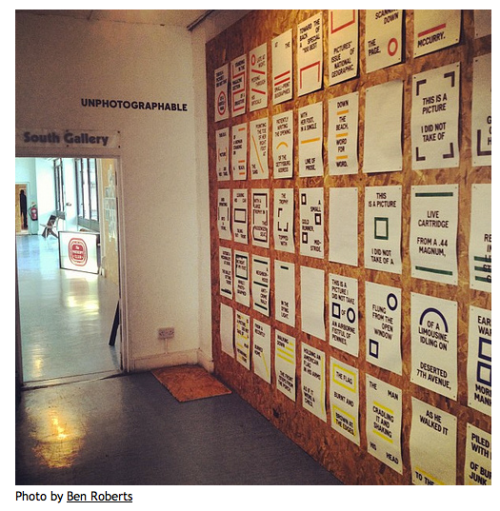Michael David Murphy Interview
Unphotographable is a catalog of exceptional mistakes. Photos never taken that weren’t meant to be forgotten. Opportunities missed. Simple failures. Occasions when I wished I’d taken the picture, or not forgotten the camera, or had been brave enough to click the shutter.
Michael David Murphy.
I first saw Unphotographable in Brighton as part of the BPF and was intrigued by the idea behind the series. As photographers and really just as people, most of us can identify with those missed moments. I can even picture a few of them in my mind now and feel gutted because I know those moments will never come back, no matter how much I try to re-construct them. What a good idea then, to recreate them in text form, and allow the words to do the talking. Aside from the missed photo-op this work brought to my mind questions of theoretical interest, relating to the nature of photography as a tool for remembrance and as a record of what may or may not have happened. It made me wonder whether these texts are more or less reliable than the images would have been themselves.
Michael David Murphy is a photographer and writer based in America.
I have a terrible long term memory, which may be partly why I’m a photographer. Memory and the-photograph-as-memory are obviously related to this discussion. Do you find you remember moments from your life better with or without a photograph?
I’m sure there’s a long-term affect from living with a photograph year after year that impresses that picture into one’s memory in a profound way. The images I “fix” into text are definitely remembered with a similar seriousness. Between photographs and unphotographables, time will tell which I’ll forget first!
What role do you think photographs play in the construction of our individual memories? Are they false memories?
I don’t think they’re false at all. I don’t know if they’re true, either; the stance on that is up to the maker. They’re a certain something — a something with certainty, even if it’s a bit of a fiction. My unphotographables are decidedly real and true to me, and in no way false — they happened, yes, but it’d be naiive to think there are parts of the frame I may not have described, that were just beyond focus or my field of view.
Your titles / captions are quite detailed and often poetic. Do you think the words you write capture things from those moments that the photograph may have missed? Or are you trying to replace the potential picture with words? How do you view this hypothetical conundrum?
I’m trying to create something out of text that resembles the urgency and import of a photograph. All of us read photographs so quickly. We can see that’s a cow and that’s a wheelbarrow. Text takes more time, so it’s my job to make the text as energized and forward as I can in order to replicate the experience we all have viewing photographs. I’m trying to hook the reader as quickly and as efficiently as possible.
Do you hope to evoke a hypothetical photograph in the ‘viewer’s’ mind or is it important to you that the image is removed entirely?
I don’t mind if the viewer sees a one-inch border on the picture and if it’s printed on fiber paper, or if it’s black-and-white or in color. I’m trafficking images, but I can’t control them after their issued — if someone sees the “picture I did not take” as a painting, or as something in three dimensions, that’s their experience, and it’s alright with me. There’s only so much I can lasso.
Most would agree that images are polysemous – i.e. they have layered meanings and multiple interpretations. When viewing images we are filtering all the information at the same time, rather than in a traditional language (or written word) where we are given information in stages, allowing us to develop an understanding as it unfolds. Do you feel your work loses something of this polysemy by omitting the image or is this the whole point?
Unphotographables are akin to watching an image form itself on paper in a bath of developer in the darkroom. They come into the clear, a word at a time. Omitting the image may not be the whole point, but it’s a necessary part of the effort, yes.
The presentation of the work seems to vary, I have seen small black text on white documents as well as larger, coloured poster style reproductions. What is the thinking behind this variable approach and how do you think they affect the readings?
The latest installation of the work is (in part) a collaboration with The Entente, a Brighton-based design firm. For years, I’d been wanting to collaborate with a great designer to see how they could shape the text in a way that might make it come alive in new and unexpected ways. The collaboration has been a great success, and I’ve incorporated it with smaller, handwritten pieces in a group exhibition called Shadow Puppets, currently on view at Georgia State University.
As a practitioner as well as writer, how does this work fit within your repertoire?
Schooled as a writer and self-schooled as a photographer, Unphotographable is the hybrid that joins the two. If everything goes according to plan, a book of the work will be published by the end of the year. It’s an ongoing, never-ending project, but it will feel satisfying to see it in yet-another-form, between two covers.




